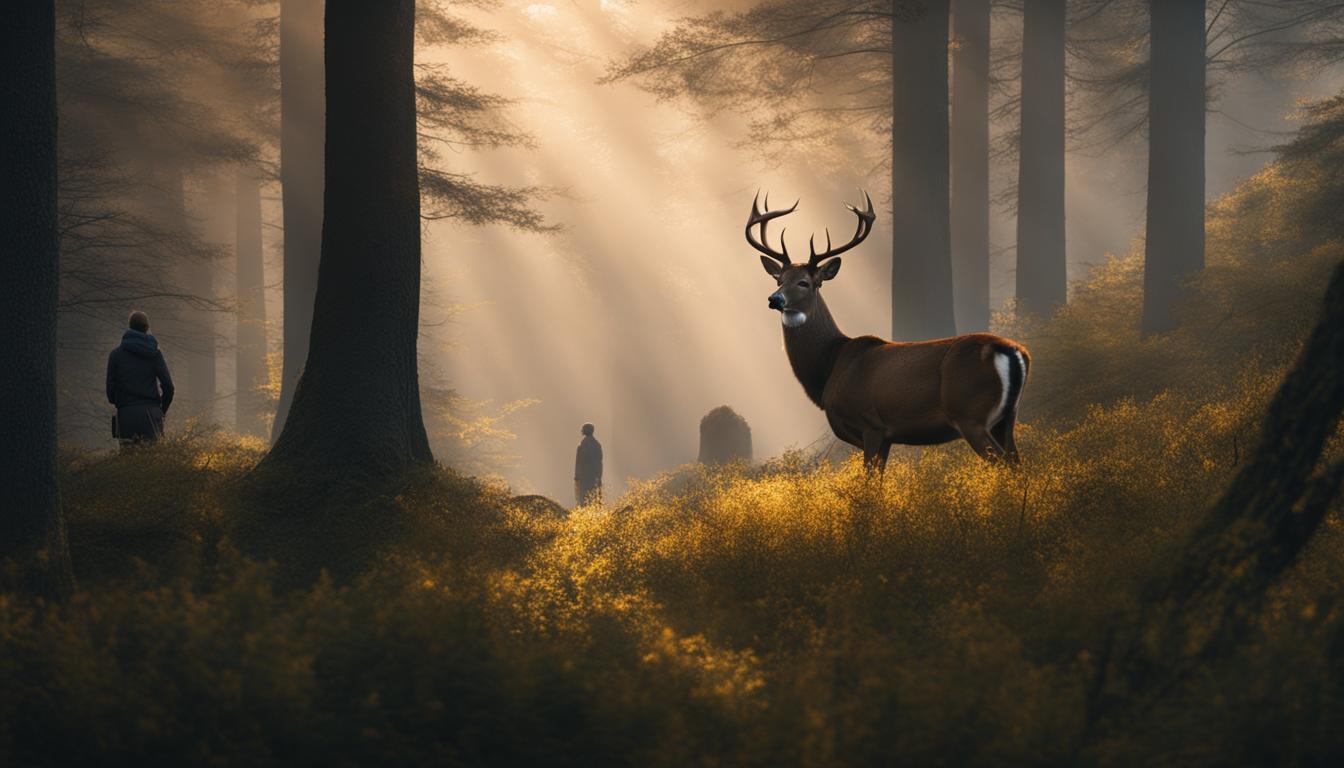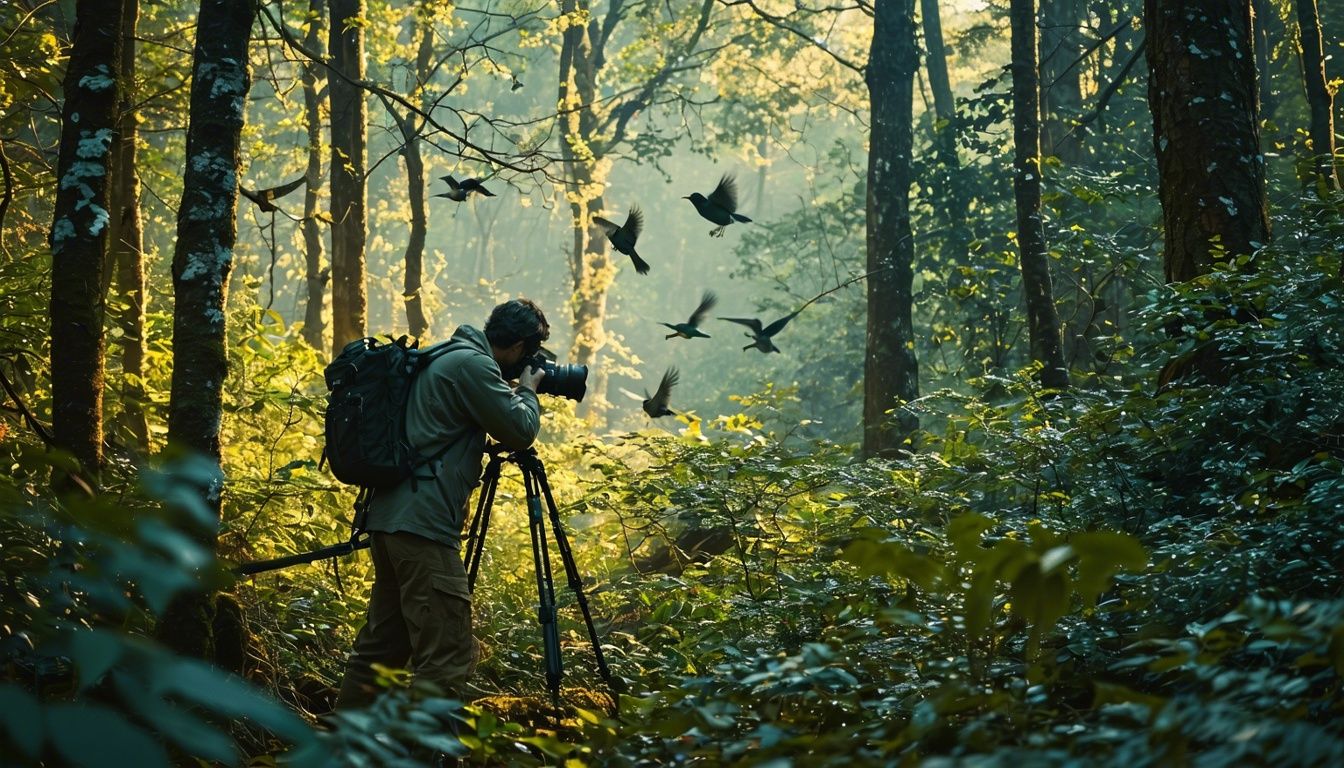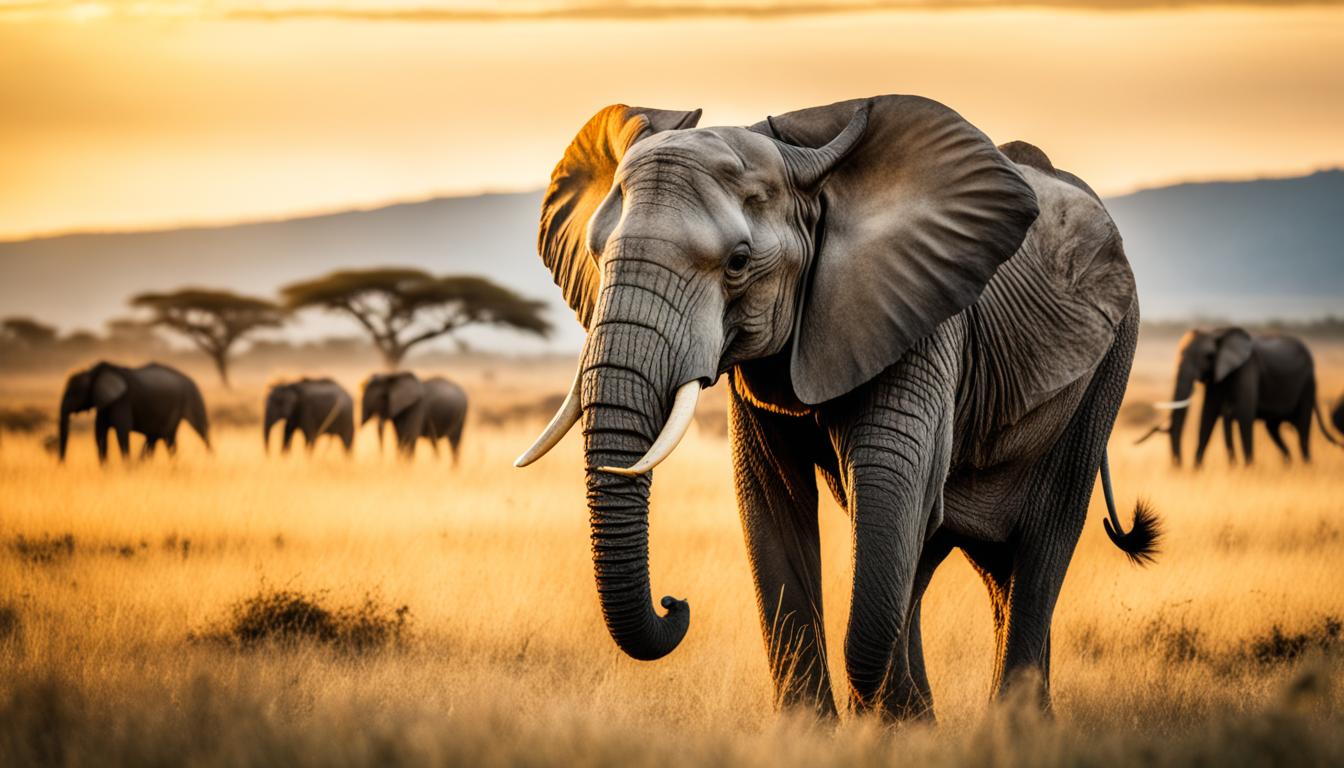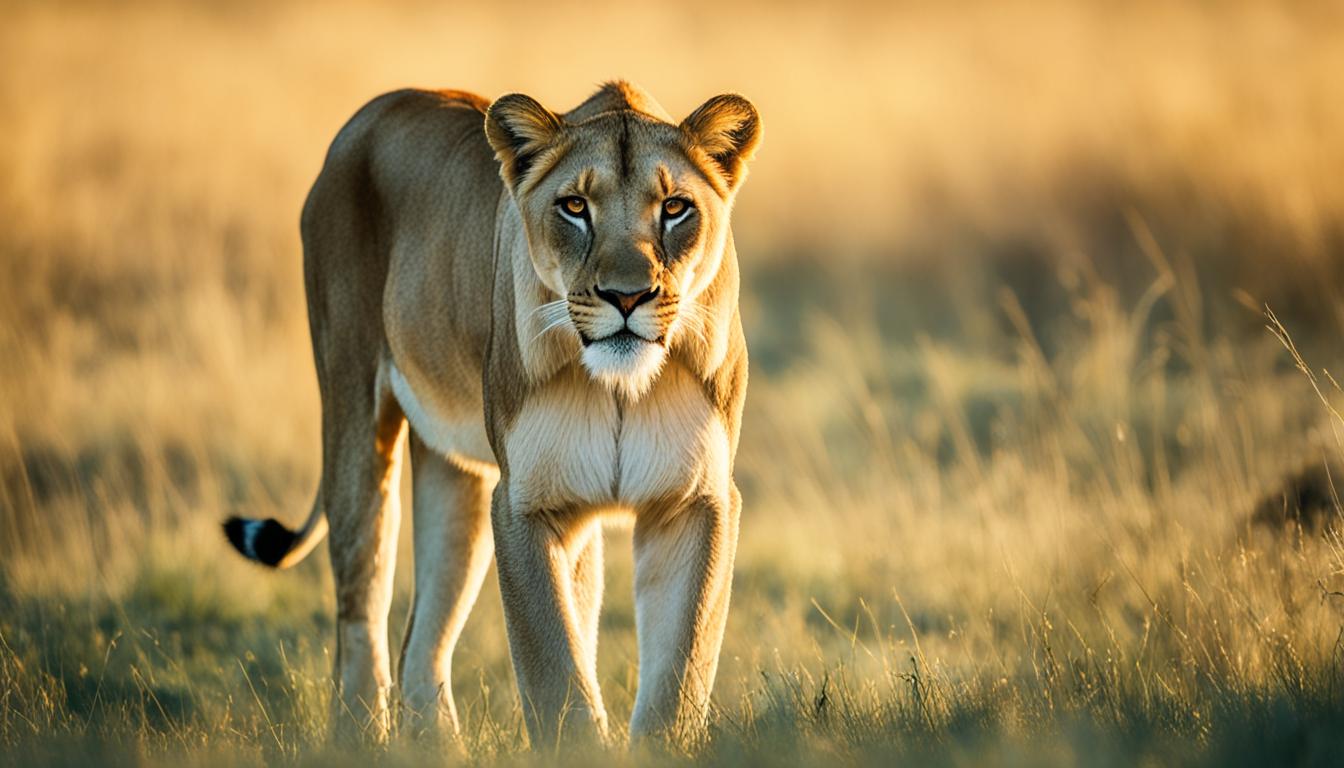Are you a wildlife photographer or enthusiast eager to capture stunning photographs of animals in their natural habitat? Mastering fieldcraft skills is essential for approaching wildlife and getting up close to capture those unforgettable moments. By honing your observation techniques and understanding animal behavior, you can enhance your chances of capturing remarkable photographs that showcase natural behavior.
Fieldcraft skills encompass a range of techniques that allow you to respectfully and ethically interact with wildlife. By learning to read animal signs, such as calls, habits, and body language, you gain valuable insights into their behavior and increase your chances of successful encounters. Spending time observing and learning about the animals you want to photograph can make all the difference in achieving outstanding results.
Key Takeaways:
- Fieldcraft skills are essential for approaching wildlife and capturing natural behavior.
- Understanding animal behavior provides valuable insights and ensures respectful interaction.
- Observation and learning about animals enhance the chances of getting remarkable photographs.
- Animal signs, such as calls, habits, and body language, offer valuable insights into behavior.
- Mastering fieldcraft skills allows for ethical and respectful wildlife photography.
Importance of Knowing Animal Behavior
Understanding animal behavior is a fundamental aspect of wildlife photography. By spending time observing and learning about the behavior of animals, we gain valuable insight into our subjects. This knowledge allows us to capture photographs that tell stories, showcasing the natural behavior and essence of the wildlife we photograph.
When we understand the behavior of the animals we photograph, we can anticipate their movements and capture unique moments in their natural habitats. Whether it’s the playful interaction between a family of elephants or the graceful flight of a bird, knowing animal behavior gives us a deeper connection with the creatures we photograph and enables us to portray their true character.
The Power of Observation
Observation is key to understanding animal behavior. By quietly observing the animals from a safe distance, we can learn how they communicate, forage for food, and interact with their environment. This kind of patient observation allows us to capture photographs that reflect the true nature of the animals and their habitats.
“The more we observe and understand animal behavior, the better we can document their natural world and raise awareness about the importance of wildlife conservation.”
Recognizing Signs of Stress
It’s crucial to recognize signs of stress in animals to ensure ethical wildlife photography practices. Stress signals may include changes in body language, vocalizations, or sudden movements. When we notice these signs, it’s important to back off and give the animals space. Respecting their boundaries reduces the risk of causing distress or disturbing their natural behavior.
By prioritizing the well-being of the animals we photograph, we can capture images that are not only aesthetically pleasing but also contribute to the conversation surrounding wildlife conservation. Our images become powerful tools for advocating for the protection and preservation of these magnificent creatures and their habitats.
Incorporating Wildlife Observation Techniques
Here are some essential wildlife observation techniques that can enhance our photography:
- Patience and Perseverance: Spending extended periods in the field allows us to witness a wide range of behaviors and increases the likelihood of capturing extraordinary moments.
- Research and Study: Before setting out to photograph a specific species, it’s important to research its habitat, behaviors, and preferred feeding grounds. This knowledge will help us anticipate their movements and be prepared for the perfect shot.
- Field Guide References: Carrying field guides specific to the wildlife we’re photographing can provide valuable information on their behavior, facilitating our understanding and allowing us to plan our shots accordingly.
- Quiet Movement: Moving slowly and minimizing noise can help us get closer to the animals without alarming them. This technique allows us to capture intimate moments from a respectful distance.
- Listening and Observing: Actively listening to the sounds of nature and observing other animal species can alert us to the presence of the wildlife we wish to photograph. Animal behavior often intertwines, providing us with opportunities to capture unexpected interactions.
By incorporating these wildlife observation techniques into our photography, we can foster a deeper understanding of the natural world, capture breathtaking images, and contribute to wildlife conservation efforts.
Concealment and Stalking Techniques
When it comes to getting close to wildlife, there are two primary approaches: concealment and stalking. Both techniques are essential fieldcraft skills that require patience, keen observation, and a deep understanding of the animal’s behavior. Let’s explore these techniques in detail.
Concealment
The art of concealment involves blending seamlessly into the natural surroundings, ensuring that the animal remains unaware of our presence. To achieve this, we need to employ careful techniques and utilize natural features to break up our approach.
Key Tips for Concealment:
- Selecting natural cover: Using foliage, rocks, or terrain features that match the surrounding environment can help us remain hidden from the wildlife we are observing.
- Camouflage clothing: Wearing camouflaged clothing that matches the habitat can aid in breaking up our human shape and making us less visible to animals.
- Silent movements: Minimizing noise and moving slowly but steadily can prevent alerting the animals to our presence.
By mastering the art of concealment, we can observe and capture wildlife behavior without causing unnecessary stress or disturbance.
Stalking
Stalking wildlife in the field is a more time-consuming approach that requires refined skills and a deep understanding of the animal’s behavior. This technique involves stealthily and gradually closing the distance between ourselves and the animal we aim to photograph or study.
Key Tips for Stalking:
- Slow and deliberate movements: Moving slowly and deliberately, paying close attention to our surroundings, helps us remain undetected while closing the gap between us and the animal.
- Reading animal behavior: By observing the animal’s body language and reactions, we can anticipate their movements and adjust our approach accordingly.
- Utilizing natural cover: Taking advantage of natural features like trees, bushes, or rocks can provide opportunities for concealed movement.
Stalking wildlife requires a high level of fieldcraft skills, patience, and persistence. It allows us to witness intimate moments and capture stunning photographs of animals in their natural habitats.
| Concealment Techniques | Stalking Techniques |
|---|---|
| Blend into natural surroundings | Slow and deliberate movements |
| Utilize natural features for cover | Observe and read animal behavior |
| Wear appropriate camouflage clothing | Utilize natural cover for concealed movement |
| Minimize noise and sudden movements | Adjust approach based on animal reactions |
Both concealment and stalking techniques require a deep understanding of fieldcraft skills and the ability to blend into nature seamlessly. By mastering these techniques, we can get closer to wildlife and capture breathtaking photographs while ensuring the animals’ comfort and well-being.

The Role of Camouflaged Clothing
When it comes to fieldcraft skills and blending into nature, one key element cannot be overlooked – camouflaged clothing. As wildlife enthusiasts and photographers, we understand the importance of becoming one with our surroundings to minimize our presence. Camouflaged clothing plays a crucial role in achieving this.
By carefully selecting colors and patterns that mimic the habitat we find ourselves in, we can effectively break up the human shape and camouflage ourselves against the natural backdrop. The goal is to become virtually invisible to wildlife, allowing us to observe and capture their genuine behaviors without causing disturbance.
Camouflage clothing serves a practical purpose in the field. It is designed to minimize shine and reduce the chances of detection by wildlife. This means that not only do we blend into the environment visually, but we also avoid reflecting sunlight or casting noticeable shadows that could give away our presence. It helps us become part of the landscape, giving us a better chance of observing animals in their natural state.
When choosing camouflaged clothing, it is essential to consider the specific habitat we will be photographing in. Different environments call for different colors and patterns. For example, in densely forested areas, earthy tones and foliage patterns help us blend seamlessly into the dense vegetation. In open grasslands, sandy or tan-colored apparel may be more suitable to match the savannah terrain.
Remember, the purpose of camouflaged clothing is not only to help us approach wildlife but also to promote ethical and respectful encounters. We want to observe animals without causing them undue stress or alarm. By camouflaging ourselves effectively, we increase our chances of remaining unnoticed, allowing us to capture incredible moments of wildlife in their natural habitats.
Paying attention to the details and mimicking nature’s colors and patterns through camouflaged clothing allows us to become an inconspicuous observer, truly immersing ourselves in the world of wildlife.
In addition to camouflaged clothing, there are other essential fieldcraft skills and techniques that we need to master to approach wildlife successfully. In the next section, we will explore the importance of wind direction and scent, and how understanding these factors can make a significant difference in our ability to observe wildlife up close.
Importance of Wind Direction and Scent
When it comes to approaching wildlife, understanding wind direction and controlling our scent are essential fieldcraft techniques. Animals possess a remarkable sense of smell and can detect human scents from long distances. Therefore, we must consider the wind direction and ensure it blows away from the animal to reduce the chances of being detected.
By carefully determining the wind direction, we can position ourselves in a way that keeps our scent from reaching the animal’s sensitive nose. This strategic approach increases our chances of getting closer without alarming or disturbing the wildlife. In addition, decreasing scent dispersal helps maintain a respectful and ethical interaction with the animals we are photographing.
Controlling Scent
To minimize scent alerts, it is crucial to avoid using highly scented personal care products before venturing into the field. Certain soaps, shampoos, and perfumes can leave a lingering scent that may act as a warning sign for wildlife. Opting for unscented or natural products helps reduce the chances of triggering any odor alerts.
“Understanding wind direction and managing our scent enables us to approach wildlife with stealth and respect.” – Our Wildlife Photography Team
By paying attention to wind direction and minimizing our scent, we enhance our fieldcraft skills and increase the likelihood of successfully approaching wildlife for incredible photographs. Empowering ourselves with these techniques allows us to blend into our surroundings and become invisible to the animals’ sensitive noses.
| Benefits of Understanding Wind Direction and Managing Scent |
|---|
| Minimizes the chances of wildlife detecting human presence |
| Increase opportunities for close encounters with wildlife |
| Reduces stress and disturbance to the animals |
| Enhances ethical and respectful interaction with wildlife |
Wildlife Photography Tips for Approaching Wildlife
Capturing stunning wildlife photographs requires a delicate approach that doesn’t disturb the natural behavior of the animals. By employing a combination of fieldcraft skills, observation techniques, and an understanding of the subject’s habitat and behavior, photographers can achieve remarkable results. Here are some valuable wildlife photography tips to help you get closer to your subjects without causing stress or disturbance:
- Get into position before sunrise: Arriving early allows you to be present in the area without attracting attention. Take advantage of the soft morning light to capture incredible images.
- Utilize fieldcraft skills: Mastering fieldcraft techniques such as the slow and low approach can help you remain inconspicuous and minimize the chances of startling the animals.
- Observe bird and animal alerts: Pay attention to the behavior of other birds or animals in the vicinity. Their reactions can provide valuable cues about the presence of potential subjects.
- Utilize natural cover: Use the environment to your advantage. By positioning yourself behind natural elements like rocks, trees, or vegetation, you can blend into the surroundings and appear less threatening to the wildlife.
- Understand the subject: Researching the preferred habitat, feeding patterns, and behavior of the species you wish to photograph can greatly increase your chances of capturing unique and compelling images.
Remember, wildlife photography is not only about stunning visuals but also about practicing ethical nature conservation. Respecting the natural world and minimizing disturbance to the subjects is crucial for the preservation and protection of our wildlife.
“Approaching wildlife with respect and consideration allows us to capture their true essence and contribute to their conservation.”
| Benefits of Wildlife Photography Tips for Approaching Wildlife | Nature Conservation Practices |
|---|---|
| 1. Capturing authentic behavior 2. Preserving wildlife habitats 3. Promoting awareness and understanding of animals 4. Contributing to scientific research |
1. Supporting conservation organizations 2. Advocating for wildlife protection 3. Educating others about the importance of ecological balance 4. Inspiring people to take action |

Benefits of Fieldcraft Skills in Wildlife Photography
Developing fieldcraft skills not only enhances our ability to approach wildlife for photography purposes but also promotes outdoor survival skills and nature conservation practices. By becoming attuned to the natural world and learning to coexist with wildlife, we can gain a deeper understanding of ecosystems and contribute to their protection and conservation efforts.
When we develop fieldcraft skills, we learn to observe and understand animal behavior, allowing us to approach them in a non-threatening and respectful manner. This not only improves our chances of capturing compelling photographs but also ensures the well-being and natural behavior of the animals we encounter.
Fieldcraft skills also foster outdoor survival skills, as they require us to navigate natural landscapes, read and interpret animal signs, and make informed decisions based on our surroundings. By honing these skills, we become more self-reliant and better equipped to handle outdoor adventures and unexpected situations.
Additionally, practicing fieldcraft skills encourages a deeper connection with nature. As we spend time observing wildlife, studying their habits, and immersing ourselves in their environments, we develop a greater appreciation for the intricate balance of the natural world. This newfound understanding fosters a sense of responsibility towards the preservation of these habitats, motivating us to actively participate in conservation efforts.
“Fieldcraft skills in wildlife photography not only allow us to capture breathtaking images but also serve as a gateway to deeper exploration, self-sufficiency, and a profound respect for the natural world.”
By incorporating fieldcraft skills into our wildlife photography endeavors, we not only elevate the quality of our work but also contribute to the larger conservation movement. Our photographs can help raise awareness about the beauty and vulnerability of wildlife and their habitats, inspiring others to take action and support conservation initiatives.
So let’s continue to develop our fieldcraft skills, embracing the challenges and rewards they bring. Remember, the journey towards becoming a skilled wildlife photographer goes beyond capturing stunning images. It is about cultivating a deep connection with nature and using our work to promote the conservation of the incredible wildlife that surrounds us.
Fieldcraft Skills and their Benefits in Wildlife Photography
| Fieldcraft Skill | Benefits in Wildlife Photography |
|---|---|
| Observing animal behavior | Enhanced understanding of wildlife, capturing natural behavior |
| Camouflage techniques | Minimizing disturbance, blending into natural surroundings |
| Navigation and tracking | Locating wildlife hotspots, following animal trails |
| Environmental awareness | Understanding ecosystems, supporting conservation efforts |
| Survival skills | Staying safe in outdoor environments, handling unexpected situations |
Exploring Fieldcraft and Survival Workshops
Are you eager to enhance your fieldcraft skills and learn essential outdoor survival techniques? Look no further than fieldcraft and survival workshops. These workshops provide a valuable opportunity for nature enthusiasts, wildlife photographers, and outdoor enthusiasts to delve into the world of fieldcraft in a controlled environment.
| Topics Covered in Fieldcraft Workshops | Survival Skills Covered in Workshops |
|---|---|
|
|
During these workshops, participants gain hands-on experience through practical exercises, simulations, and expert guidance. By immersing themselves in the learning process, participants develop a strong foundation in fieldcraft skills and outdoor survival techniques that can be applied to various scenarios, including wildlife photography expeditions.
By attending fieldcraft and survival workshops, you’ll have the opportunity to refine your camouflage techniques, learn to approach wildlife ethically, and gain insights into animal behavior. You’ll also acquire essential survival skills to navigate and thrive in the wilderness, ensuring your safety and well-being during outdoor adventures.
Whether you’re an aspiring wildlife photographer or simply passionate about immersing yourself in nature, fieldcraft and survival workshops provide a comprehensive learning experience that goes beyond the classroom. Take the leap and join a workshop to unlock your full potential in the great outdoors.
Enhancing Wildlife Photography Through Fieldcraft
Incorporating fieldcraft skills into wildlife photography can greatly enhance the quality and authenticity of your photos. By understanding animal behavior, using camouflage techniques, and honing your tracking skills, you can capture genuine moments that showcase the beauty and natural behavior of wildlife.
When it comes to wildlife photography, observation is key. By carefully studying and interpreting the behavior of animals, you can anticipate their movements and capture remarkable shots. Spend time watching how they interact with their environment, their feeding patterns, and their social behavior. This knowledge will help you predict their actions and position yourself accordingly.
To effectively photograph wildlife, it’s important to blend in with your surroundings. Camouflaged clothing can help break up your silhouette and make you less noticeable to the animals. Choose clothing that matches the colors and patterns of the habitat you’re photographing in. This will help you remain inconspicuous and allow you to get closer to your subjects without alarming them.
Tracking is another valuable fieldcraft skill for wildlife photography. By learning to read and interpret animal tracks, you can follow their movements and find the best spots to set up your camera. Look for tracks, droppings, and other signs of animal activity to guide you. Additionally, pay attention to calls and alarm signals from other animals in the area. They can indicate the presence of your intended subject.
When it comes to fieldcraft, patience is key. Take your time and move slowly and quietly through the environment. Avoid sudden movements or loud noises that could startle the animals. By practicing these techniques, you’ll be able to get closer to wildlife without causing them stress or disturbance.
Incorporating fieldcraft skills into your wildlife photography can result in photos that truly capture the essence of the natural world. By understanding animal behavior, using camouflage techniques, and honing your tracking skills, you’ll be able to capture compelling and authentic images that showcase the beauty and behavior of wildlife.
| Benefits of Enhancing Fieldcraft Skills in Wildlife Photography |
|---|
| 1. Closer proximity to wildlife for more impactful shots |
| 2. Ability to capture natural behavior and moments |
| 3. Ethical approach that minimizes stress and disturbance to wildlife |
| 4. Increased chances of photographing elusive or shy species |
| 5. Deeper connection and understanding of the natural world |
Conclusion
Mastering fieldcraft skills is essential for wildlife photographers and nature enthusiasts who want to approach wildlife and capture extraordinary moments. By investing time and effort in learning animal behavior, utilizing camouflage techniques, and enhancing tracking skills, we can create stunning images that depict animals in their natural habitats while contributing to wildlife conservation efforts.
Fieldcraft skills not only benefit photography but also foster a deeper connection with nature and promote outdoor survival skills. By understanding the behavior and habits of animals, we can observe and interact with them in an ethical and respectful manner, ensuring minimal disruption to their natural activities.
Through fieldcraft skills, such as effective concealment and stalking techniques, we can approach wildlife without raising alarm or causing distress. Additionally, having knowledge of wind direction and controlling our scent plays a crucial role in minimizing detection and allows us to get closer to our subjects.
Ultimately, mastering fieldcraft skills enhances our wildlife observation techniques, enabling us to capture authentic moments that portray the beauty and natural behavior of animals. By honing our skills in fieldcraft and wildlife photography, we not only contribute to conservation efforts but also develop a greater appreciation for the wonders of the natural world.
FAQ
What are fieldcraft skills?
Fieldcraft skills are techniques used to approach wildlife close enough for observation or photography while ensuring minimal disturbance or stress to the animals.
Why is it important to know animal behavior?
Understanding animal behavior helps photographers capture natural and authentic moments, while also ensuring ethical and respectful interaction with wildlife.
What are concealment and stalking techniques?
Concealment involves hiding oneself so that the animal remains unaware of one’s presence, while stalking requires slow and skillful movements to approach wildlife closely.
How does camouflaged clothing play a role in fieldcraft skills?
Camouflaged clothing helps individuals blend into their natural surroundings, minimizing detection and increasing the chances of approaching wildlife unnoticed.
Why is wind direction and scent important when approaching wildlife?
Animals have a keen sense of smell, and by understanding wind direction and managing one’s scent, photographers can reduce the chances of being detected by wildlife.
What wildlife photography tips can help in approaching wildlife?
Tips such as getting into position before sunrise, using a slow and low approach, and watching for other animal alerts can aid in approaching wildlife without causing stress or disturbance.
What are the benefits of fieldcraft skills in wildlife photography?
Fieldcraft skills not only enhance wildlife photography but also promote outdoor survival skills and contribute to nature conservation practices.
What can be learned from fieldcraft and survival workshops?
These workshops cover topics such as camouflage techniques, tracking, and survival skills, providing participants with hands-on experience to apply to their wildlife photography endeavors.
How do fieldcraft skills enhance wildlife photography?
By mastering fieldcraft skills, photographers can approach wildlife closer, capture compelling and authentic photos, and foster a deeper connection with nature.
What are the key takeaways from mastering fieldcraft skills?
Mastering fieldcraft skills is crucial for approaching wildlife, capturing remarkable moments, and promoting outdoor survival skills and nature conservation efforts.
How Can Mastering Fieldcraft Skills Improve Team Dynamics in Approaching Wildlife?
Mastering fieldcraft skills is crucial for navigating team dynamics with second shooter roles when approaching wildlife. Clear communication, trust, and a deep understanding of each team member’s strengths and weaknesses are key. By honing these skills, teams can work seamlessly together, leading to more successful wildlife encounters.




